Matador Network's Blog, page 1252
September 28, 2018
Flowers at the Toledo Museum of Art
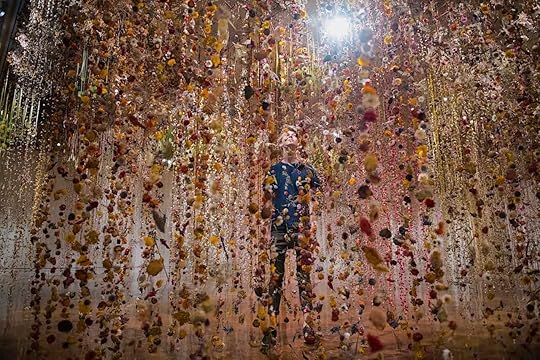
This surreal installation at the Toledo Museum of Art in Ohio sets the bar unfairly high for other art exhibits.
Using 150,000 plants and flowers native to northwest Ohio, British installation artist Rebecca Louise Law created this incredible display of cascading flowers. It’s intended to be an immersive experience, so visitors can walk among the many beautiful flower garlands and consider the relationship between humans and nature.
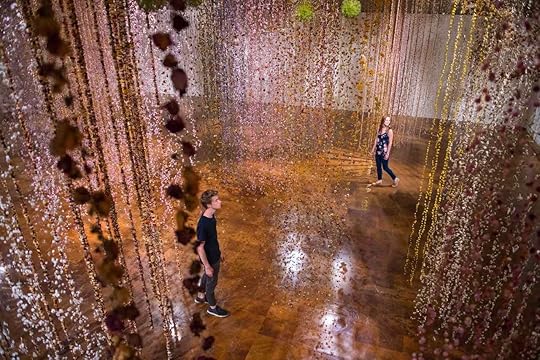
Photo: Toledo Museum of Art
The installation is called “Community,” which is truly reflective of the process required to complete the exhibit. It took 1,800 volunteer hours to gather the necessary materials, with volunteers also helping string together garlands of fresh, dried plants and flowers.
In an effort to create a sustainable installation, in “Community,” Rebecca Louise Law reused everything that she had ever used in artwork over the past 10 years, as well as new, fresh flowers.
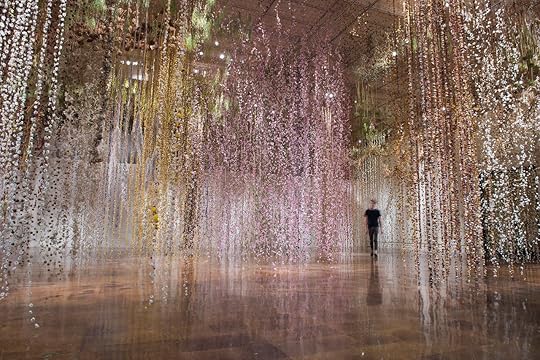
Photo: Toledo Museum of Art/Facebook
The installation at the Toledo Museum of Art will be on display until January 13th, 2019. To learn more about Law’s installation, visit the museum’s official website. Tickets can be reserved here for $10 each. 
H/T: Lonely Planet

More like this: Tokyo’s digital art museum is the coolest art display ever
The post This surreal cascade of flowers is an art exhibit like no other appeared first on Matador Network.

Best places to go in Europe in fall
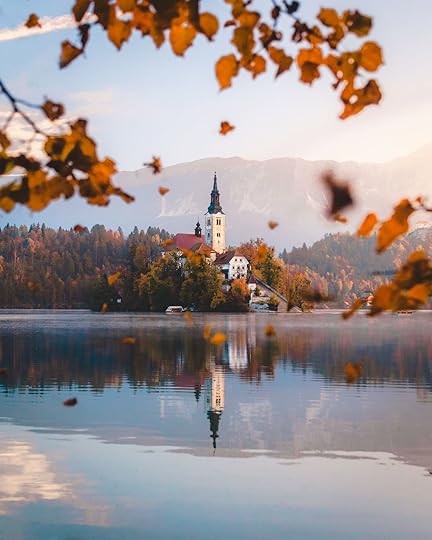
With such a diverse range of cultures, geography, architecture, and natural beauty in such close proximity, Europe has everything you could possibly want in a fall adventure. But with so many countries to visit, so much food to eat, and so many city names to mispronounce, it’s tough to know where to start. A group of friends and I recently rented a van and drove across Europe, aiming to get the full fall experience in seven different countries. Here is the beauty we witnessed.
1. Burg Eltz, Germany

While there are certainly no shortage of beautiful, medieval castles in Germany, Burg Eltz is among the most memorable. Located in the lush Moselle Valley along Elzbach river, this castle was completed in 1540, and is one of the few in the area that is perfectly preserved. There are dozens of hikes available around the castle, including the popular Eltzer Burgpanorama trail, which is particularly scenic. Castle tours are conducted every 15 minutes in German, although French, Dutch, and English tours are also available on a more limited basis.
2. Tree Tunnel, France
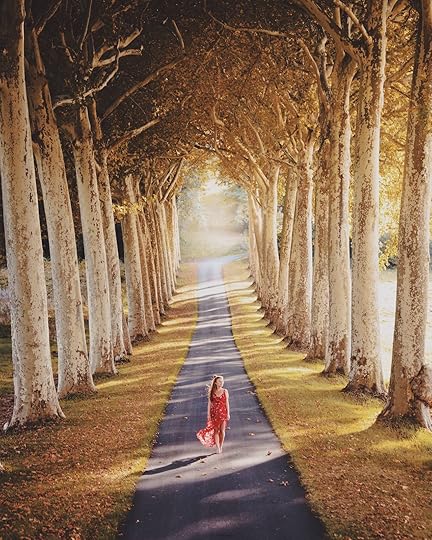
After a few days of exploring Paris, we traveled east toward the German border, where we spotted an incredible tunnel of huge trees just outside Chemin. A lonely country house sat at the end of a leaf-covered road, making for a truly perfect fall setting.
3. Hallstatt, Austria
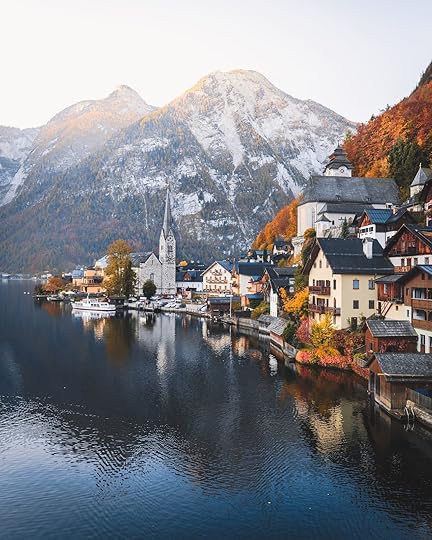
Located between the mountains on Lake Hallstatt, the town of Hallstatt in Austria looks nothing short of perfect. Dotted with 16th-century homes and filled with cafes, there are few places more peaceful. For hiking enthusiasts, there’s a trail leading to the Echern Valley glacier garden, where you can see glacial potholes, the Waldbachstrub Waterfall, and a funicular railway leading up to an old salt mine. The village of under 1,000 residents is just over an hour’s ride from Salzburg, although you’ll need to park out of town, as Hallstatt itself is refreshingly car-free.
4. Berchtesgaden National Park, Germany
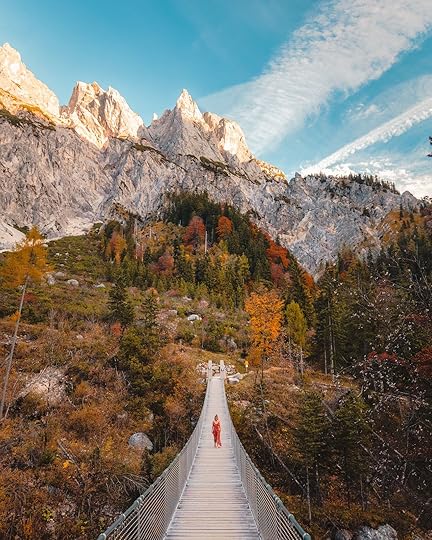
Berchtesgaden National Park is located in Upper Bavaria, covering 81 square miles. The bridge in the picture above hangs over the Klausbachtal Valley and provides stunning alpine views and an array of popping fall colors for those who cross it. You can get more epic vistas by hiking the Watzmann mountain (the highest in the park at nearly 9,000 feet), and exploring Lake Königssee, which is considered to be the cleanest lake in all of Germany.
5. Landwasser Viaduct, Switzerland
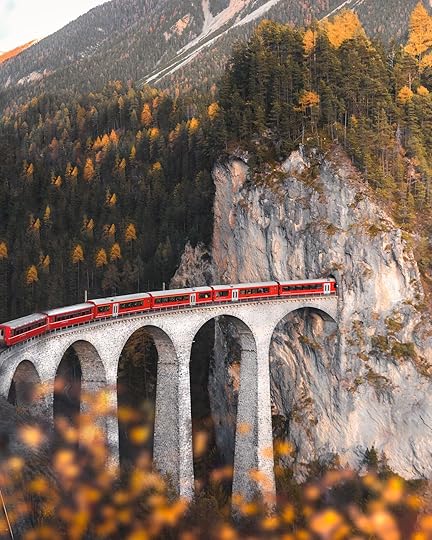
The Landwasser Viaduct on the Rhaetian Railway in the Albula is only a 30-minute walk away from the village of Filisur. Completed in 1902, the bridge is 213 feet tall, with six arches that are each 65 feet long. Completely surrounded by the Alps, the Rhaetian Railway, a World Heritage Site, passes through 144 bridges and 42 tunnels.
6. Hintersee, Germany
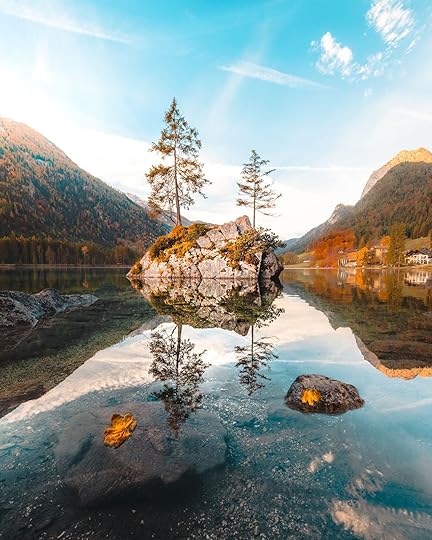
Located in the small town of Ramsau, Hintersee Lake is another great spot in the Bavarian Alps. The most scenic route to the lake is walking along a path through the Zauberwald (Enchanted Forest), and beside a mountain stream. Hintersee itself is perfect for boating, but strolling along its edge and basking in the view of the surrounding alpine peaks is pretty darn good, too. If you’d like to see the landscape as captured on canvas by famous artists such as Carl Rotmann and Ferdinand Georg Waldmüller, you can take an art-themed hike around a lake called the Painter’s Road — the trail is lined with paintings.
7. Alpe Di Siusi, Italy
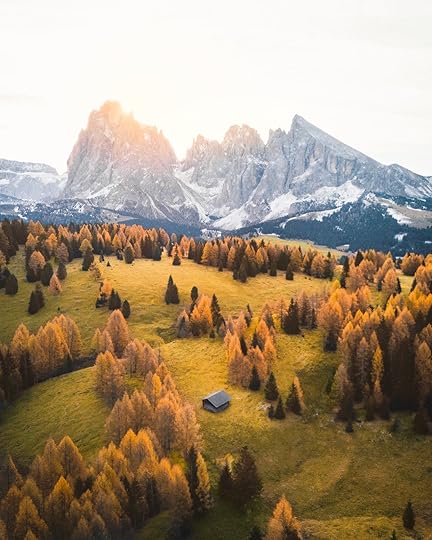
Europe’s largest mountain plateau, the Alpe Di Siusi in Italy’s South Tyrol, is the perfect place for an autumn hike or bike ride. With views of the Dolomite peaks, the area also has small forests and a smattering of settlements. The largest is called Compatsch, on the western side of the plateau. It serves as the perfect base camp for your Alpe Di Siusi trip, with hotels, restaurants offering traditional South Tyrolean cuisine, and a cable car up to one of the nearby mountains. If you’re visiting later in fall, or winter happens to come early, the area is also ideal for downhill and cross-country skiing.
8. Lake Bled, Slovenia

Lake Bled is probably Slovenia’s most recognizable spot, and for good reason. With the deep blue water and surrounding forests and mountains, Lake Bled is stunning. But you can do more there than just take cool photos. If it’s still warm enough, you can go kayaking, swimming, or use the lake as a starting point for hiking through the Slovenian Julian Alps. If you’re so inclined, you can also take a tour of the various nearby wine estates. Getting there is easy, too. Just take a bus or train from the capital of Ljubljana for a few euros, and you’ll be there in under an hour.
9. Neuschwanstein Castle, Germany
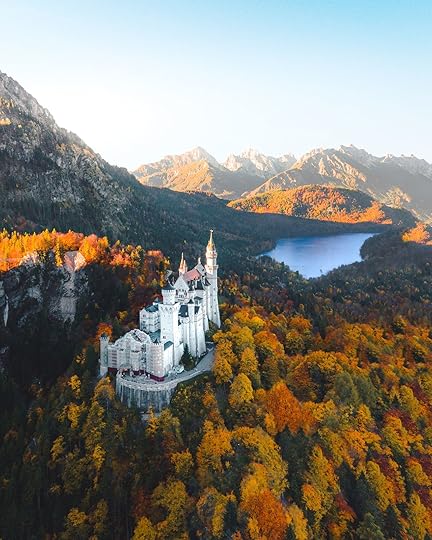
Built in the 19th century by King Ludwig, the Neuschwanstein Castle looks like it’s right out of a fairytale (it inspired Disney’s Magic Kingdom after all). Located in the Bavarian Alps, on top of a hill near the town of Füssen, the castle has a panoramic view of the countryside. Ludwig built the castle in honor of the composer Richard Wagner. Neuschwanstein itself translates to “New Swan Castle” — a reference to one of Wagner’s characters called the “Swan Knight.”
10. Vintgar Gorge, Slovenia

One of the most popular natural features of Slovenia, the bridges and walkways of Vintgar Gorge make hiking relatively easy. The canyon’s winding wooden walkways lead past the turbulent Radovna River, ending at the 42-foot-high Šum Waterfall — Slovenia’s highest river waterfall. There’s also a cafe just before the waterfall, where you can relax.
11. Plitvice Lakes, Croatia
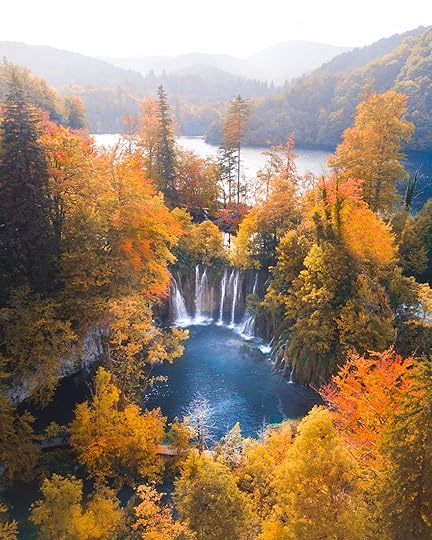
No visit to Croatia is complete without a trip to Plitvice Lakes National Park. While it might be a little farther east than you were planning on venturing, Plitvice Lakes is well worth the detour. The park, located in the heart of the country, about 80 miles from Zagreb, includes 16 natural lakes connected by a series of waterfalls. Covering 115 square miles, the park is full of deer, bears, wolves, boars, and rare birds, with the forest’s richest colors really coming out in autumn. The park is open year-round, for a fee of $8 per visitor. 

More like this: The most scenic drives through Europe in the fall
The post 11 stunning photos that will make you plan a trip to Europe this fall appeared first on Matador Network.

Beautiful waterfalls in Costa Rica

Costa Rica is one of the most picturesque places on Earth. The tiny country is very mountainous, with over 50 volcanoes — five of which are currently active — and dense, tropical forests. Deep in the lush rainforest canopy of the country are countless waterfalls, including the highest one in Central America, El Salto del Calvo. As 25 percent of the tiny country is protected for conservation, most of the cascades are located within some of the 32 National Parks and have entrance fees, but that shouldn’t stop you from checking them out — they’re well worth a few bucks. Here are the seven most amazing waterfalls you should go chasing while in Costa Rica.
1. La Fortuna Waterfall

Photo: Pavel Tvrdy/Shutterstock
La Fortuna Waterfall, located near Arenal Volcano, is the most famous one in Costa Rica. It’s a 10-minute drive from the center of the town of La Fortuna. If you’ve rented a car, just head down Diagonal 301 or take a taxi for $10 one way. La Fortuna Waterfall opens at 7:00 AM, so arrive early to beat the crowds and have this incredible feat of Mother Nature all to yourself.
To reach the basin of the 230-foot-tall waterfall you’ll have to go down 530 concrete stairs with railings. Don’t fret, the path is super sturdy and well traversed. Once you reach the bottom of La Fortuna Waterfall, go for a leisurely dip in the natural swimming hole to cool off. Make sure to bring lots of water as you’ll have to climb right back up the massive stairway. You can stop at many viewpoints on the way back up if you need to take a breather.
Entrance prices are currently $15 for foreigners, paid in cash at the entry to the fall. The fee is collected by a sustainability nonprofit that manages the park. Note that, even though La Fortuna Waterfall is located in Arenal Volcano National Park, you don’t need to enter the park and pay the park entrance fee to go and see the falls.
2. La Paz Waterfall
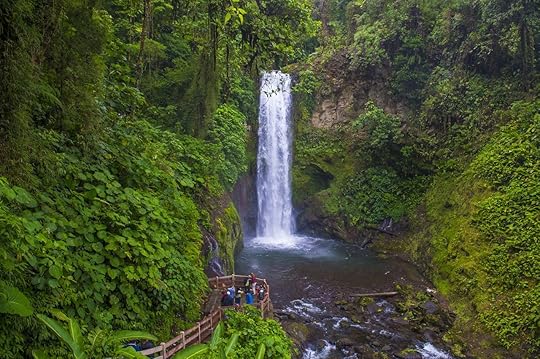
Photo: Kobby Dagan/Shutterstock
The best way to unwind after arriving in San Jose via a long, international flight is to head out to the La Paz Waterfall Gardens, just an hour and a half north of San Jose. The roads are well paved, so the best way to get there is by rental car — you may be able to get an Uber ride, but it’ll cost you. The trails to explore the park are well marked and pretty low impact, but there are quite a few stairs.
The highlight of the park is La Paz Waterfall and its massive drop of 110 feet. You can also see La Paz Waterfall from the road and snap a photo, but nothing beats getting up close and personal. You’ll also be able to visit Magia Blanca Waterfall, which is the largest at 120 feet, Templo Waterfall, Escondida Waterfall, and Encantada Waterfall. There’s no swimming allowed at any of the waterfalls at La Paz Waterfall Gardens.
Entrance to the park costs $44 per adult for foreigners and can be bought online with a credit card. The price is steep but includes over two miles of walking trails and an animal sanctuary. Stay the night in the onsite lodge to maximize your time and be the first to enter the park when it opens at 8:00 AM.
3. Rio Celeste Waterfall
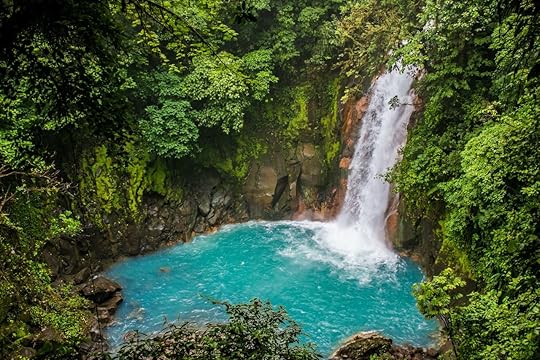
Photo: David Gonzalez Rebollo/Shutterstock
The Rio Celeste Waterfall is located within the Tenorio Volcano National Park. In Spanish, celeste is the name of the picture-perfect blue color of the sky — and this waterfall seriously lives up to its moniker.
The cost to enter Tenorio Volcano National Park is $12 for foreign visitors, which needs to be paid in cash. Aim to arrive by 8:00 AM, when the park opens, in order to fully enjoy all that the nature reserve has to offer. It’s best to rent a car for the day to reach the park, which is about six miles from Bijagua town.
A concrete path cuts through the jungle en route to Rio Celeste Waterfall and is an easy trek, but it does have some stairs. You can’t swim in the turquoise basin, so after you’ve enjoyed the vistas at the waterfall, make your way to the nearby natural hot spring in the park.
4. Llanos de Cortez

Photo: worldroadtrip/Shutterstock
Llanos de Cortez is, hands down, the most beautiful cascade in Costa Rica. It’s a great first stop if you’re flying into Liberia Airport, as the Llanos de Cortez waterfall is in Bagaces just 16 miles south of Liberia. The drive should take about 30 minutes in a rental car or taxi. For now, it’s free to enter the park, but that’s likely to change as the Llanos de Cortez waterfall continues to grow in popularity.
The trail to reach the waterfall is short and takes most people just 10 minutes, but it is pretty steep, so don’t try it in sandals. After the short jaunt, you’ll be rewarded with the sight of a mighty, 50-foot-wide curtain of water that pours down from 40 feet up.
There’s also a natural freshwater beach with white sand on the banks of the pool. And don’t forget to climb with caution on the rocks behind the waterfall for a behind-the-scenes view.
5. Nauyaca Waterfall

Photo: Silverman1/Shutterstock
Nauyaca Waterfall is a quick drive inland from the beach town of Dominical and is the perfect waterfall in Costa Rica for those who want to spend time in the jungle. A taxi from Dominical to Nauyaca Waterfall costs $20 each way. The hike is on a gravel road and moderate with many curves up and down the side of a cliff. The round-trip distance is about five miles long. There’s also the option to pay to be taken to the fall by truck for $25 round-trip or $10 one-way.
Nauyaca Waterfall is located on private land and managed by the family who owns the property. It costs $8 to get in and can be paid in cash with US dollars or the local currency, Costa Rican colones.
The fall is truly spectacular with 200 feet of powerful water spillage over multiple tiers of rocks. Take a swim in the lower-level, 20-foot-deep pool. There’s nothing as divine as a cool dip after hiking. Note that it’s impossible to get into the pool during the rainy season due to water surge that makes the flow fast and dangerous.
6. Catarata Aquiares
View this post on InstagramA post shared by Turrinomada (@turrinomada) on Jan 21, 2018 at 6:13pm PST
The Aquiares Waterfall, located in Turrialba, is off the beaten path and a favorite among Ticos, as Costa Ricans call themselves. You’ll need to walk about a third of a mile through the coffee plantations of the Aquiares village to find the Aquiares Waterfall, but it’s marked well on Google Maps. If you get a little lost, ask a local to point you in the direction of the catarata, the Tico word for waterfall.
It’s free to enter to check out the 132-foot cascade that gushes into a natural swimming pool. The best way to experience this waterfall is to float on your back and gaze up at the flowing water.
7. Gravity Falls
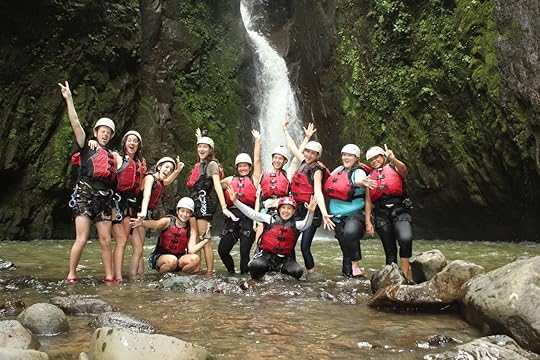
Photo: Lola Mendez
If you’re keen on an adventure, check out the privately-operated Gravity Falls in La Fortuna for a day of exploring a beautiful canyon with several waterfalls. Licensed canyoneering guides will teach you how to rappel down a cliff next to a 132-foot-tall waterfall followed by swinging on a rope into a massive natural pool, playing on natural rock slides, and climbing sheer rock walls. The tour’s grand finale is jumping down a 36-foot waterfall. If it’s too high for you, note that there are several spots for secure waterfall jumping that range in height from 10 to 30 feet.
The half-day excursion can be booked online or at the Desafio office. It costs $125 per person, including pick-up from your accommodation in La Fortuna, gear, and lunch. 

More like this: How to move to Costa Rica and live there on the cheap
The post The 7 most amazing waterfalls in Costa Rica appeared first on Matador Network.

Baby panda in Japan needs a name

The Adventure World wildlife park in Japan has a new baby panda resident, and the tiny cub is just as cute as you would imagine.

Photo: Adventure World
The female panda was born on August 14th and weighed only 2.64 ounces. Now that she’s put on some weight and looks more like an actual panda instead of a minuscule pink kitten, the park wants your help in naming her. To submit your suggestion, apply online or mail a postcard including the name, phonetic spelling, and reason for your name choice.

Photo: Adventure World
If you’d like to get her parents’ blessing before deciding on a name, you can meet both at the park. Eimei, the father, was born in 1992 in China, and came to Adventure World when he was two years old. He’s described as “quiet, and always looks calm.” The mother, Rauhin, was born at Wakayama in 2000, and in 2008 became the first giant panda born in Japan to give birth. She and Rauhin have a total of nine children now — seven females and two males.
To see the cub herself before making the important naming decision, you can check out this live webstream and coo and caw at the magnificent creature.
Submissions are due by November 16th, and the winner will be announced online soon afterward. 
H/T:

More like this: South Dakota just got two new baby snow monkeys, and visiting them this winter will be extra adorable
The post appeared first on Matador Network.

48 hours in Leavenworth, WA
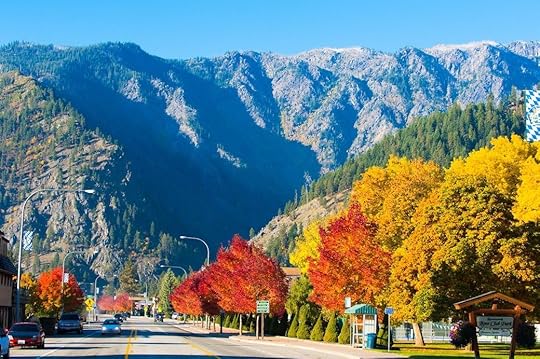
The little Bavarian-styled town of Leavenworth sits two hours east of the hubbub of Seattle, in the foothills of the Cascades. And while there’s definitely pretzels lining the streets — yep — and amazing beer and carillon bells and lederhosen, there’s also hiking. Stargazing. Leafy fall drives. Theatre, shopping, fruit stands, cider, and killer views.
This once-upon-a-time day-tripper town is now a Seattleite’s long-weekend getaway. A PNW getaway. A countrywide getaway. And in fall? It cannot be beat. Here’s how to spend the best weekend of your autumn, right here in Leavenworth.
Friday night
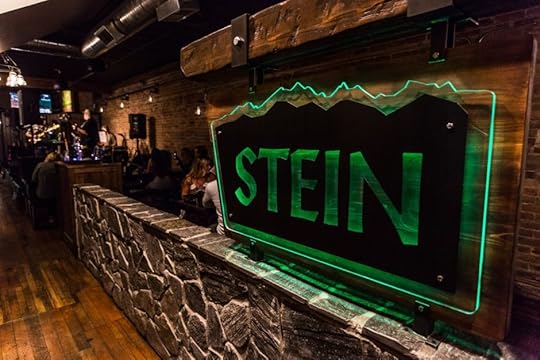
Photo: Erin Joy Nash for Stein
Roll into town. Are you staying in a glamper-style yurt? A suite on Front Street? A million-dollar log cabin with more fireplaces than you have square feet back home? A campground steps from the Wenatchee River? Great. Go there. Set up. Sit for a sec and soak it in. Then make your way to Front Street.
This is going to be your new favorite drag. We’ll cover the shops and sights in a bit, but for now, food. Let’s start with a bang — here’s the rundown:
Sulla Vita – If you’re anywhere within two blocks, it’s their pizza your nose can’t get away from. The fig & prosciutto pie is unbelievable, and not in one of those strange what-can-we-combine-for-effect kind of ways. It’s just really, really, really, really good.
Mana Restaurant – You’ll get eight courses of foraged food prepared by yoga masters. It’s a three-hour commitment to do dinner here, and there’s only one seating, two or three days a week (because, again, they have to go find that awesome food). And in the middle of it all, they’ll test you to see if you can decipher the ingredients in the previous courses.
If you’re here for the Deutschland experience, hit up the Bavarian Bistro for one of their soft pretzels. They’re warm and salty, and the homemade cheese sauce makes it a double-billing. You can also pair it with traditional mustard, chipotle dijon, bacon coconut peanut butter, or chocolate cream cheese for dipping. Or, as I call it, dunking and slathering.
We’ve got two more full days, so let’s not get carried away. With food, at least. Drinks? Another story. After dinner, head to the patio at Icicle Brewing Company for a cold one, stick around the Bavarian Bistro for one of their kickin’ cocktails, or check out Stein — they’ve got 50+ beers on tap, all color-coded to make selection less overwhelming.
Saturday morning
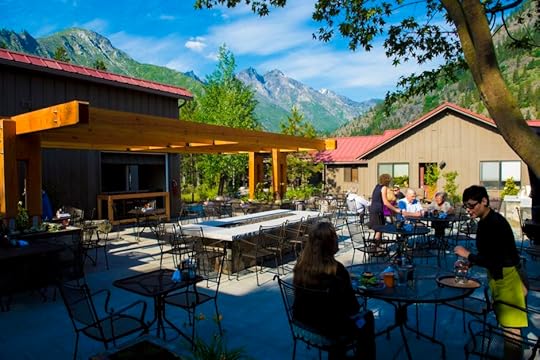
Photo: Sleeping Lady
If you’re the “all-I-want-is-coffee” type, hit up J5 Coffee for your sustenance (I suggest anything with their maple bourbon flavoring). If you’re like me and recognize that carbs are the closest you can get to God, hit up the Bavarian Bakery for their Apfelstrudel or a cherry danish. And meat-eaters? O’Gradys = corned beef benedict.
Whatever your pick, toss those crumbs to the birds and jump in the car for the fall leaf-peeping drive to Plain. Make sure to start out on Chumstick Hwy, going in a loop counterclockwise. Nature’s colors are a 128-box of Crayolas here, the drive cutting through the middle of the Okanogan-Wenatchee National Forest. Vine maples, aspen, red cedar, loads of varieties of pine — it’s Washington State at its finest.
Break up the drive — and the bold autumnal colors — with a stop at the newly constructed yet still old-school 59er Diner. The hot pink and teal signage isn’t lying about having the best burgers around. Grab a quick one (and a blackberry milkshake, if you have any self-respect), and then drive back down Hwy 2. Feel free to pull over for photo opps and splashing in the Wenatchee. It’s right there.
Saturday afternoon

Photo: Steve Voght
Time to head back toward Leavenworth. Since it’s Naturday (Nature Saturday? No? Just me?), get outdoors and out of the car. You’ve got a ton of options:
Hike up Icicle Ridge – It’s a four-mile thigh workout to amazing views that justifies that milkshake. Look for a small brown sign on Hwy 2 about 1.5 miles from town, go up the gravel for about six seconds, turn left, and you’ll see the trailhead.
Bike Freund Canyon – The trail is a skinny single track with plenty of switchbacks, and it takes you up over the valley and through a handful of area orchards.
Paddleboard Lake Wenatchee – If you’re a pro paddleboarder, you could take on the Wenatchee River, but the rest of us will stick to the lake and its Switzerland-esque views.
Stroll through Waterfront Park – This follows the Wenatchee at a much more tranquil pace — aka however fast your feet take you. The three-mile Waterfront Park Trail leads to a number of beachy outlets for toe-dipping, too.
Or you could always just stay and play in the river.
Saturday night

Photo: Jacqueline Kehoe
Workout secured, go shower, put yourself back together, and track down dinner. A freshly ground reuben or a sausage hoagie at Renaissance Café or Baren Haus, some pub fare from Blewett Brewing Co., or one of the Friday-night options should do the trick.
For nightlife, make a beeline to Bushel & Bee to celebrate the day. The owner, Kayla, is a straight-up superhero with fantastic taste in cider and beer. She built the place herself (“I’d say I knocked it down to the studs, but I took those out, too”), and while she’s not brewing yet, her regional stock — and the schedule of live music and events — makes that a non-issue.
Before you sit down, locate the bookshelf full of “adult” coloring books and colored pencils in the center of the room. If you finish yours — preferably while knocking back One Tree’s Lemon Basil Cider — you get to hang it up on the very, very, very rainbow wall. (Look for the one about mermaids. That one’s mine.)
Sunday morning
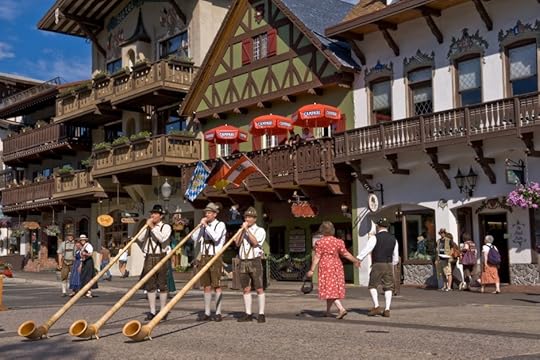
Photo: Leavenworth Chamber of Commerce
Sandwiched right between Front Street Park and Waterfront Park on the corner of Commercial and 9th is a spot that’s easy to miss. Local Yokel is small and deconstructed…kind of like their menu. Their breakfast burrito might be the farthest your six dollars ever went — they’ve got sandwiches, bagels, and wraps, too — and the smoothies (snaps to blueberry coconut) should be winning awards. Otherwise, or in addition to, make the four-minute jaunt to Smallwood’s Harvest and load up on produce. Their fruit selection is so distracting you might not even notice the onsite goats that you’re completely welcome to pet and coo over.
Then it’s shopping time. If you’re anything like me, you’d rather it be literally any other time. This is what Amazon is for, right? But in this scenario, both you and I are wrong — shopping means something different in Leavenworth. My last Leavenworth morning went from two floors of Christmas to 30 free samples of cheese (I went for the double-cream gouda, thanks) to subversive car air fresheners to Earl Grey with Speculoos Cookie ice cream to being stared at by 6,000 nutcrackers. If that smoothie didn’t wake you up, this certainly will.
Sunday afternoon
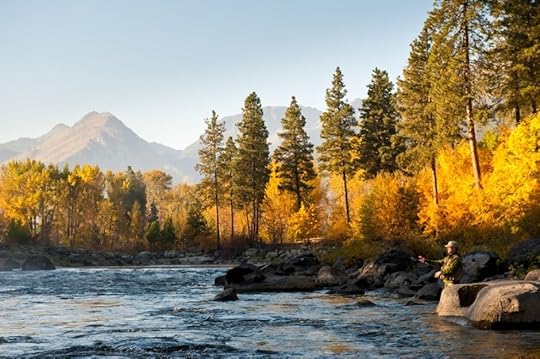
Photo: Icicle TV
Get out of the vortex — that is, if you want — and take a break from your “Front Street hypnosis.” What’s the opposite of being lulled into a buyer’s trance? Adrenaline.
Ideas: Head up to Mountain Springs Lodge for ziplining, fly fishing, or mountain horseback riding. Go for a round at Leavenworth Golf Course (look around for bears or a stray moose playing a hole). Hike the Tumwater Pipeline Trail, or just settle in for a photo sesh on the old Pipeline Bridge. Do whatever water activity you’re itching to tackle at Lake Wenatchee State Park. Or check out any of the above ideas you didn’t get to yesterday.
Sunday night
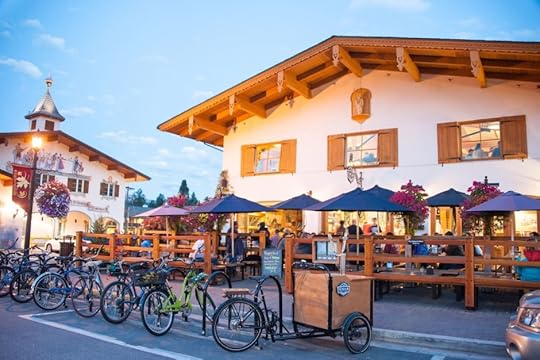
Photo: Dzhan Wiley for Icicle Brewing Company
It’s officially dinnertime, followed by dessert time. Here’s your abridged 101:
Pavz Cafe Bistro – “North Cascade Cuisine” at its finest. For dinner, eye the angry shrimp salad or one of the seafood crepes. For dessert, their sweet crepes, if you can fit ‘er in.
Mozart’s or Uli’s – The former has a balcony, the latter has a patio, and both have fondue that rivals — if not surpasses, depending on your tastes for kirsche — any in Switzerland.
Watershed – They have an elk meatloaf that will convert anyone whose childhood cafeteria ruined the dish for them. Also consider their steamed clams, and pair whatever you feel like with a meringue cocktail.
And, of course, don’t leave town without a quick stop at the Gingerbread Factory. Grab a gingerbread man to accompany you on the ride home. Or to eat. Or one to set on your mantle to remind you that Bavaria isn’t so far away. 
The post How to spend a perfect 48 hours in Leavenworth, WA this fall appeared first on Matador Network.

September 27, 2018
9 best coffee cities in the world

Coffee drives the world unlike any other product. Not only is it the fuel for people on every continent looking to kick start their days or stay up long into the night, but it’s also a canvas for artisans looking to take a simple pleasure beyond its utilitarian purposes.
“Every specialty coffee shop owner or roaster is someone that woke up one day and said, ‘You know what, coffee is amazing. I’m going to make this my life,’” says Tom Baker, the co-founder of the specialty coffee liqueur Mr. Black. Because of this, certain cities in the world have emerged as hubs for roasters to pursue their craft.
Everyone knows the regular coffee hotspots along the Pacific Northwest — looking at you Seattle — but there’s so much more. The regions that grow coffee, particularly in Africa (the home of the bean) and South America, used to only export coffee because of harsh economic systems implemented during colonial rule. Now those regions rank among the top places for coffee devotees. From Africa to Australia, we spoke with some coffees pros to determine the top nine coffee cities in the world.
1. Nairobi, Kenya

Photo: Java House/Facebook
Calling Kenya an upstart coffee country would be like calling Germany an upstart beer country. Some 150,000 coffee farms dot the country. Despite its long history as the origin of prized coffee beans, however, coffee hasn’t traditionally been the drink of choice for locals. Colonizers left a tea-drinking culture, and coffee was too expensive. That’s slowly starting to change.
Modern coffee culture kicked off with Nairobi Java House, which first opened in 1999 in a shopping mall and has expanded to places around the city. When in the past you would seek out the best Kenyan coffee in the US or Europe, you can now get it from the source at countless upstart coffee brewers and a handful of local roasters.
2. Bogotá, Columbia

Photo: Azahar Coffee/Facebook
Coffee isn’t native to Colombia, but it’s been around for centuries. The country has exported coffee since the early 1800s, and today, it’s one of the top producers in the world.
Most coffee production centers around rural areas, but Bogotá is a fitting urban location to taste Colombia’s best. A rising professional and artist class in the capital city is reaching for coffee to get their creative juices flowing. Three nearby mountain ranges and plenty of microclimates drive region-specific tastes from 21 producing states. Bogotá’s coffee culture is prized enough that cities in Australia are naming coffee shops after it, but not so well known as a coffee destination that it’s overrun with beard-and-bowtie baristas.
Top spots: Azahar Café for a cup and a stroll and Amor Perfecto for classic, original Bogotá cup of coffee.
3. Melbourne, Australia

Photo: St Ali/Facebook
Australia is a coffee-obsessed continent, but Melbourne stands out. Everywhere you turn there’s a coffee shop making the next best cup of Joe you’ve ever had.
“For us Aussies, coffee is more than just a beverage; it’s an obsession, a point of national pride,” Baker says. “We’ve evolved from an Italian coffee heritage into world leaders in specialty coffee. And our obsession with coffee extends well into the evening. That’s why we made Mr. Black — our cold-brew coffee liqueur — we’re just caffeine obsessed here down under. Did you know that the highest selling cocktail in Australian bars is an Espresso Martini? That should give you a good indication of our caffeine dependency.”
Top spots: St. Ali Coffee Roasters for ethically sourced beans from Africa, Asia, and central and South America. There’s also Seven Seeds, which has a rotating list of seasonal coffee beans.
4. Manchester, England

Photo: Grindsmith/Facebook
Coffee culture is strong in Manchester. The number of independent roasters and coffee shops has exploded over the past couple of years, and the city hosts an annual Manchester Coffee Festival to promote education and support local spots.
“Manchester really blew me away,” Baker says. “Coffee is booming in the UK, and when I stepped off the train from London into Manchester’s Grindsmith — the first of about 10 phenomenal shops I went to — I was just so impressed. Young winners crafting the future for us all.”
Top spots: Grindsmith for regionally roasted coffee. There’s also Barbecue, which is owned by Passion Fruit Coffee Roasters, for espresso and pour-overs, as well as Takk for a long list of coffee options and a warm environment.
5. Sydney, Australia

Photo: Single O/Facebook
“Sydney, Australia, home to Little Marionette Coffee Roasters, is a very underrated coffee city,” Sid Chitnis, the co-founder of Saltwater Coffee in New York City, says. A city like Sydney makes the list because even if you disregard all of the great coffee shops and the people who are obsessed with coffee culture, there are world-class roasters.
“The beans they are making there are served all over Australia and the UK and even in our East Village shop. You’d be hard pressed to find a bad flat white in the town, and that is why we use them at Saltwater Coffee, spreading Australian coffee culture one flat white at a time in NYC.”
Top spots: Reuben Hills for small batches of coffee roasted on the upper level of the building, and Single O for a look at one of the places that put single-origin coffee on the map in Sydney.
6. Reykjavik, Iceland

Photo: Mr Doomits/Shutterstock
Nothing screams “I need a warm cup of coffee” like a cold country. Iceland’s most famous Nobel Laureate, Halldor Laxness, wrote scenes about Icelandic coffee drinking where people would consume four or five cups in a casual setting. The capital city is one of the best places to discover why. There are few commercial coffee places in Reykjavik, making it a place where local coffee culture shines brighter than mass-market corporations.
Top spots: Reykjavik Roasters for a brewing and roasting workshop along with your cup of joe, and Cafe Haiti for Haitian-sourced beans.
7. Anchorage, Alaska
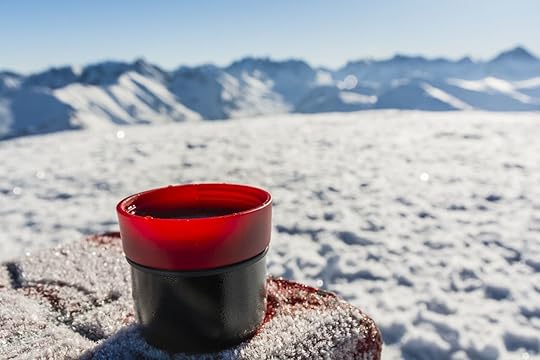
Photo: gubernat/Shutterstock
There are more places to get a coffee per person in Anchorage than anywhere else in the US. Daylight lasts for more than 20 hours in the summer, so there are a lot of reasons to stay awake. Then in the winter, well, we all know how hard it is to wake up without the sun. Caffeine helps. Thankfully Anchorage has plenty of it. Coffee carts abound, as do the coffee roasters that cook up million pounds of beans every year.
Top spot: Snow City Café, which is visited by both locals and visitors like former President Barack Obama.
8. San Diego, California

Photo: Heartwork Coffee Bar/Facebook
Don’t let the laid-back California atmosphere deter you. San Diego is more than just hanging out by the beach and drinking from the many (many) craft breweries. There are more than 10 local roasters, 430 coffee houses, and a trade group called the San Diego Coffee Network to promote the scene and host competitions. The variety and wide availability of good coffee prove that you don’t have to be in a cold and wet city to experience a good cup. You might even find that the beach is a better place to sip on coffee than a musty store.
Top spots: Heartwork Coffee Bar for specialty drinks and Dark Horse Coffee Roasters for a relaxed vibe.
9. Wellington, New Zealand

Photo: Flight Coffee/Facebook
Flat whites — a small espresso drink with microfoam — may have been invented in Sydney, but Wellington perfected them. New Zealand has the most coffee roasters per capita in the world, and Wellington has more than its fair share, making it all too easy to stumble upon your next favorite coffee shop. Just take note: Kiwis like their coffee strong.
Top spots: Flight Coffee Hangar for well-sourced coffee with easily available farm information and Customs Brew Bar for a laid-back espresso. 

More like this: 7 unique ways people drink coffee around the world
The post The 9 best coffee cities in the world appeared first on Matador Network.

Six Flags hosting a coffin challenge

This coffin challenge takes “playing dead” to a whole new level. In preparation for Fright Fest, and to get you in the mood for Halloween, Six Flags has announced a “30-Hour Coffin Challenge,” taking place on October 13. Six participants will each be given their own cozy coffin, and $300 will be awarded to anyone who can stomach 30 hours inside.
You don’t have to stay for the entire 30 hours straight, though. A six-minute bathroom break will be allowed every hour, and meals, drinks, snacks, and even a phone charger will also be provided. Contestants are also permitted to bring a pillow and blankets.
If you’re one of the coffin-dwellers, though, you’d better hope none of your fellow contestants make it the full 30 hours. In the event that more than one person lasts the full time, the winner of the money will be determined by raffle. If the $300 isn’t a sweet enough prize to entice you to spend the next two days in a coffin, the winner will also receive two season-long park passes, a prize pack, and other souvenirs from Six Flags.
To participate, you must be 18 years or older with valid photo ID, not be inhibited by severe medical conditions, be able to lay completely flat in a 2’x7’ coffin, and sign a waiver form at check-in.
The challenge will take place at the Six Flags park in St. Louis, and you’ll need to apply by October 3rd. The lucky (or unlucky) contestants will be chosen on October 4. 
H/T: Thrillist

More like this: The spookiest small towns in the US to visit this Halloween
The post Six Flags will pay you $300 to spend 30 hours in a coffin appeared first on Matador Network.

Best fitness retreats in the US
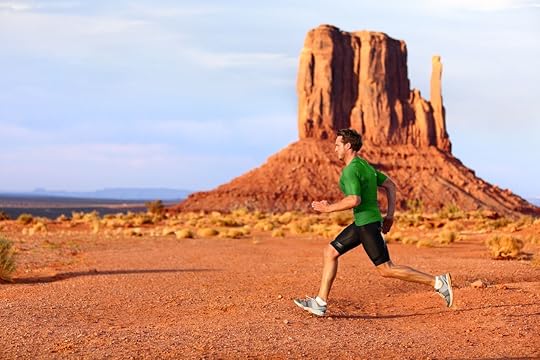
Did you get off track this summer in terms of diet and exercise? Not to worry — fall is the perfect time to kickstart your fitness goals and establish a healthy (and liveable) routine before the temptations of the holidays come around. These fitness-first wellness retreats and boot camps across the US will help you hit the reset button and eliminate obstacles to progress toward your health and happiness goals. Plus, they’re in pretty spectacular locations that are sure to motivate you to get outside and get moving.
1. Adventure retreat at Red Mountain Resort in St. George, Utah

Photo: Red Mountain Resort/Facebook
With a backdrop of red rock cliffs and canyons — plus easy access to nearby national parks — southern Utah’s Red Mountain Resort is an inspiring setting to make progress on your fitness journey. The resort offers retreat packages centered around adventure, health, wellness, and personal discovery, and all of them include three healthy meals every day, guided hiking, biking trips, yoga, and fitness classes. Beyond that, you’ll have the freedom to tailor your trip to your personal goals. An average day at Red Mountain Resort might consist of a 6:30 AM breakfast, morning hike, afternoon kayak trip, and an evening spent at the spa to wind down.
2. Immerse and thrive at Sunrise Springs Spa Resort in Santa Fe, New Mexico
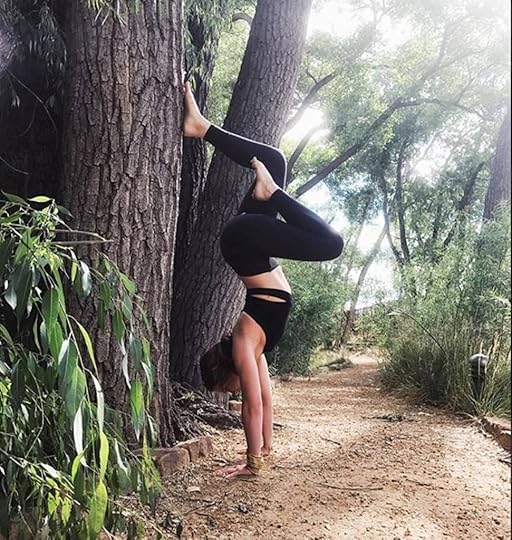
Photo: Sunrise Springs Spa Resort/Facebook
Book the Immerse + Thrive package at Sunrise Springs only if you’re seeking what the resort calls a “transformative wellness experience” — as the curriculum extends beyond just your exercise regimen. Guests work with Medical Director Dr. Sally Fisher, M.D., to evaluate levels of physical, mental, emotional, and spiritual health, then develop a customized wellness plan to integrate into their lives. In addition to fitness classes, you receive daily gourmet farm-fresh meals, access to the spa’s private outdoor mineral-infused soaking tubs (plus a daily spa credit to use as you please), counseling sessions, yoga, meditation, horticulture lessons, expressive arts classes, culinary instruction, and even puppy play time.
3. Health makeover at Cal-a-Vie Health Spa in Vista, California

Photo: Cal-a-Vie Health Spa/Facebook
Stints at Cal-a-Vie Health Spa are available in three-, four-, and seven-night packages with perks including nutritionally balanced meals, spa services, unlimited fitness classes, nutritional lectures, cooking demonstrations, and even a fitness evaluation resulting in a full wellness profile to help you advance toward your best life. Guests are also provided Muse headbands during their stay, which can be used in conjunction with any of the 20 different mind-body-spirit classes on offer, ranging from Qigong to meditating in a 400-year-old chapel.
4. Refresh yourself at Canyon Ranch in Tucson, Arizona

Photo: Canyon Ranch/Facebook
One of the most prestigious names in the world of spas, Canyon Ranch offers the ultimate in both relaxation and personal wellness initiatives. If you’re serious about revitalizing your life this fall, sign up for a week-long stay at Canyon Ranch’s Life Enhancement Center, which promises “seven days to change” — and has a 30-year track record to back up that claim. The structured curriculum can focus on brain health, weight loss, mindfulness, or spiritual renewal and usually includes fitness classes, nutrition plans, analysis and strategizing sessions, goal-setting opportunities, and more. Canyon Ranch also has locations in Lenox, Massachusetts; Las Vegas, Nevada; and at sea on various cruise lines.
5. Yoga reset at Two Bunch Palms in Desert Hot Springs, California

Photo: Two Bunch Palms/Facebook
Kickstart your yoga practice with a retreat to Two Bunch Palms, where daily classes take place in a celestial dome. With options for yoga newbies such as gentle morning stretches, therapeutic yoga, and individual sessions that cater to your particular needs and interests, you don’t have to be a master at yoga to enjoy this escape to California’s Coachella Valley. To refocus your mind and gain mental clarity, there are also guided water meditation classes held in the resort’s outdoor mineral-rich hot soaking tubs, which stem from a 600-year-old natural spring. And after you’ve finished a power yoga session, you can enjoy the on-site restaurant Essense, which serves local fare and artisanal cocktails.
6. Moab Mindful Running Retreat at Red Cliffs Lodge in Moab, Utah
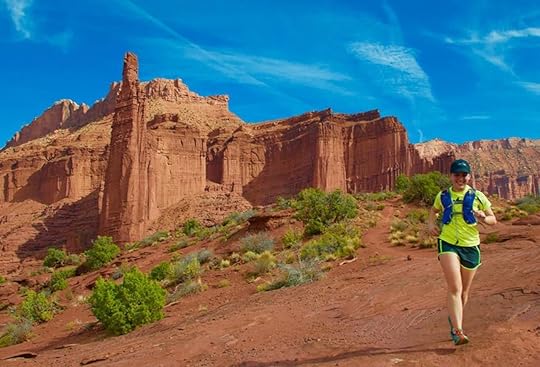
Photo: Run Wild Retreats & Wellness/Facebook
With dates in October and November, the Moab Mindful Running Retreat is intended for consistent runners and wannabes alike (though with four- to nine-mile runs on the agenda, jogging should be at least on your radar before you sign up). Attendees participate in daily guided trail runs through the red rock canyons, “mindful running” workshops, restorative yoga, natural running form clinics, and more — all in pursuit of helping runners up their game, avoid injury and burnout, and build a sustainable running practice.
7. Detox and reset at the Ranch at Live Oak in Malibu, California

Photo: The Ranch/Facebook
Whether it’s time to take back your health or simply re-calibrate, stays at the Ranch at Live Oak range from a four-day jumpstart to a ten-day total detox and practically guarantee results. Each day consists of an intense physical fitness regimen — eight hours of low-impact activity, including a four-hour group hike each morning — coupled with a 1,400-calorie organic plant-based diet (served in a greenhouse, of course). Guests will also receive medical diagnostic testing and body scans, a healthy cooking class, and a daily deep-tissue massage as part of their package at the Ranch. 

More like this: These retreats will help you quit smoking in paradise
The post The 7 best fitness camps in the US that will inspire you to get in shape appeared first on Matador Network.

Best international ferry rides
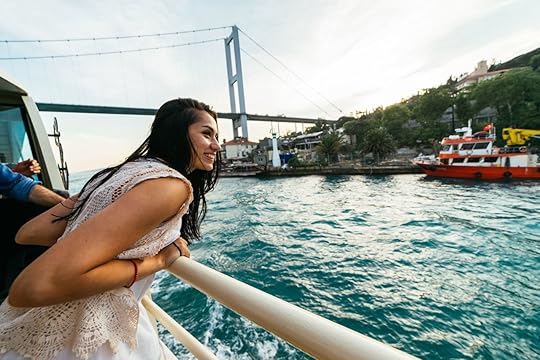
Ferries don’t always come to mind when we think of international transit. For some, they’re just those boats that take tourists to the Statue of Liberty or shuttle them around the Sydney Harbor. For others, they’re nothing more than commuter vessels. But cruising between countries is a great way to travel when you’re sick and tired of airport security or simply prefer the scenic route. In many cases, ferries even represent the quickest or cheapest way to get around. Keep these international crossings in mind next time you plan a multi-nation vacation for a new perspective on global vagabonding.
1. Sweden and Poland
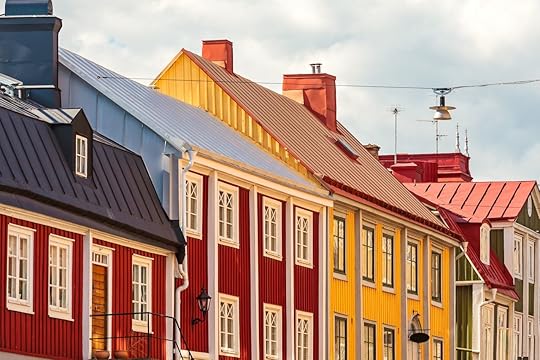
Photo: Dutch Scenery/Shutterstock
Sweden and Poland are separated by the Baltic Sea with roughly 110 miles between their closest cities. To get between the two countries, we recommend boarding a Polferries vessel in Ystad, Sweden, and debarking in Świnoujście, Poland, or vice versa. The six-hour journey costs roughly $50 for a one-way ticket. On-board entertainment includes shopping and dining areas, a cinema, sundecks, a nightclub, and a business center. Unity Line also travels between Ystad and Świnoujście while a third carrier, Stena Line, makes crossings between Gdynia, Poland, and Karlskrona, Sweden, though that route can take up to twice as long and costs $145 one way.
2. Russia and South Korea

Photo: Ovchinnikova Irina/Shutterstock
It takes a full 24 hours to get between Russia and South Korea across the East Sea, also known as the Sea of Japan, but the flying-averse can thank the DBS Cruise Ferry line for providing water-based transport from Vladivostok to Donghae. Single economy tickets cost $205 with steadily increasing prices through the second, first, and VIP classes, maxing out at $1,910 for a President Suite. Infants under two ride free, and there are special discounts for children under 12, students under 30, and groups of 15 or more.
3. Tunisia and Italy
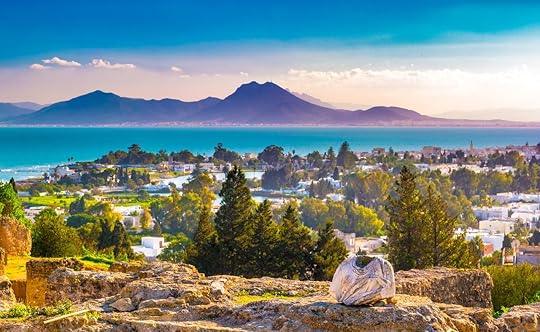
Photo: Romas_Photo/Shutterstock
Grandi Navi Veloci makes regular trips across the Tyrrhenian Sea from Italian cities like Genoa, Palermo, and Civitavecchia to Tunis, the capital of Tunisia. The Palermo-Tunis route is significantly quicker than its sister trips, which jump from around nine hours to upwards of 24 in the case of the Civitavecchia-Tunis crossing. Without a car, one-way tickets from Palermo will run you anywhere from $60 to $160, depending on your cabin preference. Prices go up for the longer voyages with fares starting at around $115. Note that boarding for all trips begins four hours before your ferry departs.
4. El Salvador and Nicaragua
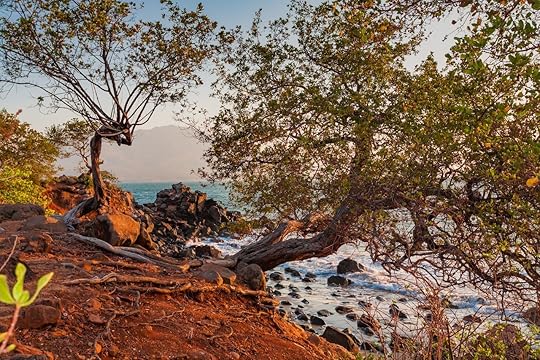
Photo: ConceptMatch/Shutterstock
Hop on a Cruce de Golfo vessel and cross the Gulf of Fonseca for a more pleasant passage between these two countries than you’ll get on a long, bumpy bus ride or unnecessary flight. The express ferry from Potosí, Nicaragua, to La Unión, El Salvador, costs $65 per person and takes just two hours. More complex itineraries to destinations like San Salvador are also available on the website, complete with shuttle transfers where necessary. Cruce de Golfo ferries depart on Tuesdays and Saturdays.
5. Japan to China

Photo: Luciano Mortula – LGM/Shutterstock
Ferrying across the East China Sea between Japan and China is far from the fastest way to get around, but it provides a nice opportunity to soak up the scenery. If you’re sold on the idea, book the overnight Shanghai Ferry from Osaka to Shanghai, a 45-hour journey that costs about $200 dollars. It’s no luxury cruise line, but there are plenty of amenities to keep you busy on board, including Japanese-style baths, a lounge, mahjong room, duty-free shop, game room, and restaurant complete with karaoke. The biggest downside is that the lower-class cabins are limited to shared lodging.
6. Finland and Estonia

Photo: kavalenkava/Shutterstock
Three ferry lines make travel across the Gulf of Finland between capital cities Helsinki and Tallinn doable year round. Tallink Silja has the most options with six daily crossings while the Eckerö and Viking Lines each run three ships per day. Tallink Silja will get you to your destination the fastest, in just under two hours, but the Eckerö Line generally offers the best deals with tickets going for as little as $15 depending on your travel dates. Be sure to book in advance as the ease of travel between the two cities means that the Helsinki-Tallinn ferries often sell out pretty quickly.
7. Morocco and Spain

Photo: Evannovostro/Shutterstock
Morocco and Spain lie just opposite one another across the Strait of Gibraltar, where the Atlantic Ocean meets the Mediterranean Sea. The most popular and convenient ferry route is from Tarifa, Spain, to Tangier, Morocco, which takes anywhere from 30 minutes to an hour. High-speed operator FRS is your best bet for the Tarifa-Tangier voyage, costing around $45 one way. FRS also connects Tangier with Spanish hotspots like Barcelona, Málaga, and Algeciras. Other carriers that follow similar routes include Balearia, AML, and Trasmediterranea, giving you tons of options to get across the Strait of Gibraltar hassle-free.
8. Singapore and Malaysia
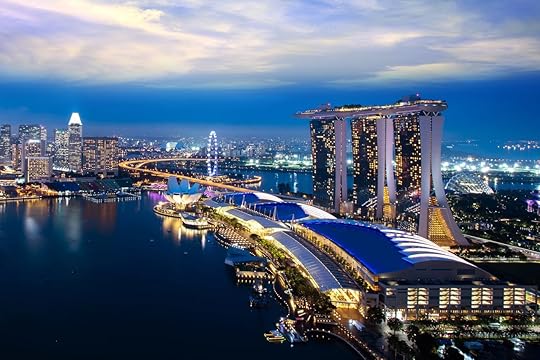
Photo: MOLPIX/Shutterstock
Ferries operated by Limbongan Maju travel the Singapore Strait from Changi, Singapore, to Tanjung Belungkor, Malaysia, daily with the most frequent crossings held over the weekends. It’s a short 30-minute ride that will run you between $20 and $40 for a one-way ticket subject to your travel dates. The cheapest fares are in March and October, and the most expensive are in April and September. Going from Singapore to Malaysia, you’ll depart from the Changi Ferry Terminal and arrive in the state of Johor near Desaru, a fishing village on the Malaysian peninsula.
9. Argentina and Uruguay

Photo: Don Mammoser/Shutterstock
Day-tripping to coastal Uruguayan cities is common among visitors to Buenos Aires, who have the option of sailing across the Río de la Plata to capital city Montevideo, beach resort Punta del Este, and UNESCO-recognized Colonia del Sacramento. Buquebus is the most reliable operator with Colonia Express coming in a close second. Ferries are offered an average of three times per day with the fastest trips going to and from Colonia del Sacramento in about an hour. Prices increase from around $50 to about $60 for the two-hour trip to Montevideo and roughly $100 for the five-hour journey to Punta del Este. There are also a handful of connections between smaller cities like Tigre, just north of Buenos Aires, and Carmelo in western Uruguay.
10. Netherlands and the UK
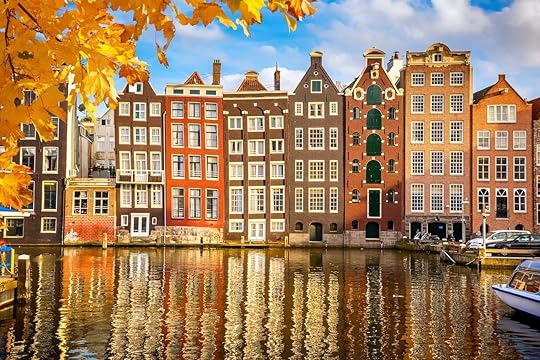
Photo: S.Borisov/Shutterstock
Eurail passes are famous for facilitating easy travel around the European continent, and ferry crossings are often included in your pass. For a leisurely journey across the North Sea, book with DFDS Seaways for a 15-hour trip between Amsterdam and Newcastle or P&O Ferries to get from Rotterdam to Hull in just under 11 hours. If you’re in a hurry, we recommend taking a Stena Line vessel from the Hook of Holland to Harwich in Essex, England. Prices for a single ticket range from approximately $50 to $90.
11. Croatia and Italy

Photo: Ihor Pasternak/Shutterstock
The Croatian coast is just a hop, skip, and jump from the Italian Peninsula. Popular routes between the two include crossing the Adriatic Sea from Bari to Dubrovnik, Ancona to either Split or Hvar, and Venice to Pula. Jadrolinija and SNAV are the favored operators, though you’ll find a handful of offers with the Liberty and Adriatic Lines, as well. The Jadrolinija ferry from Bari to Dubrovnik only runs between April and October while boats leaving from Ancona generally run year round. No matter the route, travel times hover around 10 hours, and one-way tickets cost an average of $60 for the most popular crossings. Just be sure to reserve a spot well in advance, especially over the summer months. 

More like this: Millennials are suddenly cruising more. Here’s why.
The post 11 of the coolest countries you can travel between by ferry appeared first on Matador Network.

Best fall campsites in the South
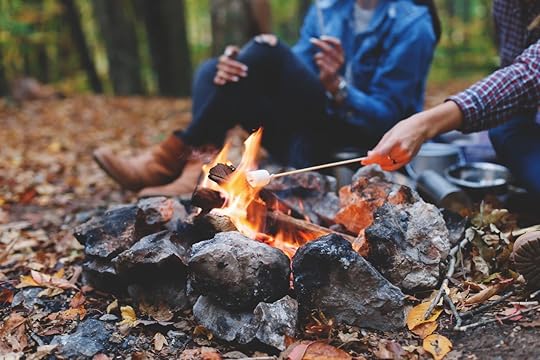
Summer may be over, but head to the American South and you’ll find great places to camp deep into the fall months. From Florida to South Carolina, campgrounds have fewer crowds and plenty of space to set up a camp chair, light a campfire, and enjoy the fall season at a different pace than in the summer months. The South is a great place to explore, and the scenery in state and national parks is a unique experience unto itself. These seven spots might just convince you to make fall camping down south an annual tradition.
1. Ocala National Forest — Florida
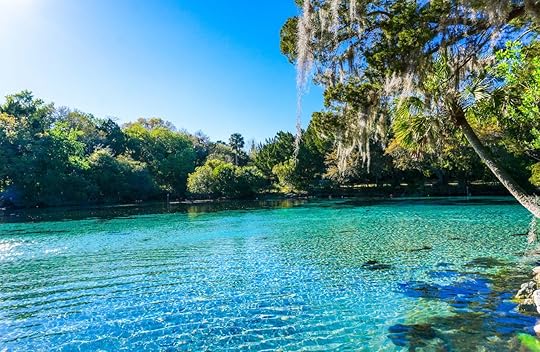
Photo: Adventures On Wheels/Shutterstock
Ocala National Forest, north of Orlando, might be inland from Florida’s coasts, but water is still very much part of the experience here. Streams and lakes abound in the forest, and several springs — including Juniper Springs and Alexander Springs Creek — make this vast area of pine forests, live oak groves, grasslands, and swamps one of the most popular national forests in the country. That’s all the more reason to enjoy it after the summer crowds depart; with the mild Florida temperatures, you can even enjoy straight through winter.
The 67-mile National Florida Scenic Trail bisects the park, but you can hike along plenty of shorter loops and offshoot trails, as well. You’ll find extensive mountain-biking opportunities, but the real draw here is the water. Canoe or kayak down the springs; the seven-mile Juniper Springs Run is ranked as one of the best runs in the nation. You can also cool off in the lakes and snorkel in the clear water.
You have multiple campgrounds to choose from. Juniper Springs Recreation and Campground, located inside the Ocala National Forest, has 78 campsites, plus hiking trails and a historic millhouse. Campsites are $22 per night, reservable here. Each campsite is equipped with a picnic table, fire ring, grill, and lantern post. Campsites can accommodate motorhomes, trailers, and tents. Restrooms with hot showers are available.
2. Fall Creek Falls State Park — Tennessee
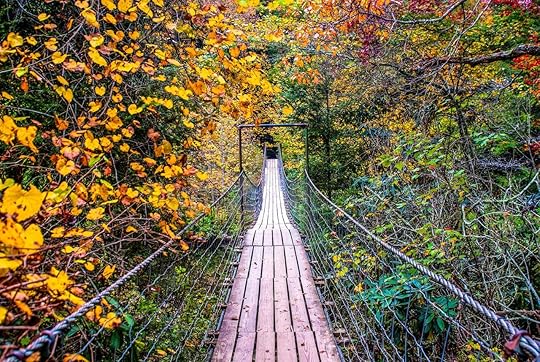
Photo: Maxine Livingston/Shutterstock
Fall Creek Falls State Park spreads across more than 26,000 acres on the eastern tip of the Cumberland Plateau, has 56 miles of trails of incredibly diverse forest — oak, beech, poplar, and hemlock are just some of the species that flourish here. The variety of trees makes for stellar fall hues of brilliant crimson, burnt orange, and golden leaves.
Adding to the beauty at any time of year are streams, gorges, cascades, and waterfalls, including the park’s namesake Fall Creek Falls. At 256 feet, it’s the tallest waterfall in the eastern US. In addition to Fall Creek Falls, others worth checking out include Piney Falls, Cane Creek Falls, and Cane Creek Cascades. Besides the falls and miles of trails, the park has a Canopy Adventure Course with wobbly bridges, rope swings, zip lines, and other challenges that are a fun way to spend a couple of hours.
The largest park in the state also has 222 campsites in five different areas. Consider backcountry camping at one of the 16 campsites located in four different areas along the overnight backpacking trails. You can purchase groceries at the camp store or buy prepared food at the snack bar. There’s even a coin laundry facility, open year-round. Rates are $8 to $35 per night, and you can reserve here.
3. Cloudland Canyon State Park — Georgia
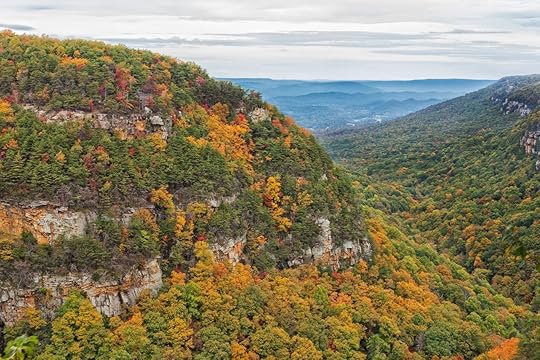
Photo: Jim Vallee/Shutterstock
The 3,500-acre Cloudland Canyon State Park is one of the loveliest state parks in Georgia, with deep gorges, cliffs, and crazy rock formations. It has 64 miles of hiking trails through lush forests, along with streams, waterfalls, cascades, and panoramic overlooks. The most strenuous of the treks include a 1,000-foot elevation gain. For mountain bikers, 30 miles of paths include plenty of intense single-track trails.
The park also has several caves, open through October, that can be explored with permits or on a tour. Fishing, horse riding, and even disc golf are other options here. The park has 72 campsites with a combination of RV, tent, and backcountry options that you can reserve. If you want the camping experience with a little less dirt, the park also has several cottages and yurts you can book.
4. Uwharrie National Forest — North Carolina

Photo: digidreamgrafix/Shutterstock
If you think you’ve missed your opportunity to leaf peep when October ends, head to Uwharrie National Forest, where the fall color extends well into mid-November and often through Thanksgiving. Enter through the Birkhead Wilderness Area and access 5,160 acres of land ripe for exploring. The Uwharrie Mountains have the distinction of being possibly the oldest mountain range in America — more than 500 million years old. Scientists believe that the area was once a chain of huge volcanic peaks reaching 20,000 feet high.
Nowadays, the tallest peaks in the chain rise barely more than a 1,000 feet. Their attraction lies instead in the forests of hardwoods and pines, small lakes, and the Uwharrie River. The forest’s largest lake, the 5,350-acre Badin Lake, lies on the northwest corner of the park and is excellent for fishing, swimming, and boating. Beyond that, hiking, horseback riding, and four-wheel driving all are popular pastimes.
You don’t expect to find a mountain range in the middle of the state, but it’s there — and surprisingly pristine as the area only allows hiking and tent camping. Camping is year-round, and all sites have graveled tent pads, fire rings, and a light hook. For primitive camping, check out West Morris Mountain, Woodrun Trailhead, and Yates Place. Reserve here.
5. Pilot Mountain State Park — North Carolina
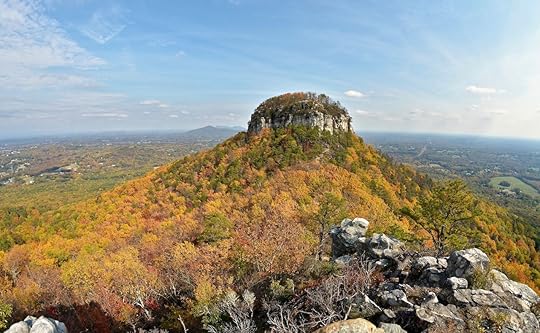
Photo: Xian Zhang/Shutterstock
Pilot Mountain, a National Natural Landmark, seems to rise out of nowhere in the rolling foothills near the Blue Ridge Mountains — reaching 1,400 above the valley floor. Modern travelers find it as useful for navigation as the Saura Indians did centuries ago, hence the “pilot” name. Even more unusual than its height relative to the neighboring landscape is the quartzite “knob” at the top of it, which looks like a little cupcake set atop the mountain with a forest for frosting.
Beyond ascending Pilot Mountain, you can rock climb, rappel, horseback ride, paddle the Yadkin River, and hike on everything from easy to strenuous trails. The park has 49 campsites for tents and trailers; some can accommodate RVs without hookups or a dump station. The south bank of the river offers primitive paddle-in campsites. Sites are open from March 15 to November 30. Each site has a tent pad, table, and fire pit with a grill. Drinking water and hot showers are available. You can reserve here.
6. South Cumberland State Park — Tennessee

Photo: dansif/Shutterstock
South Cumberland State Park has over 90 miles of trails where you’ll discover waterfalls, wildflowers, vistas, and historical areas. Besides hiking and backpacking, the park is well known for its rock-climbing routes. Spots like the gorge near Foster Falls have both sport and traditional routes while Denny Cove has over 150 routes. The Stone Door is a big rocky ledge above the lush forest. Registration for all rock climbing is required.
If you prefer, you can hike to the Stone Door and places like Foster Falls. The park also offers multiple programs throughout the year, including interpretive walks, canoeing, introductory rock climbing, animal shows, instructional classes, stargazing, creek critter surveys, and more.
Ninety-three campsites (and one rustic lodge, the Hobbs Cabin) are located within 12 backcountry campgrounds across the Fiery Gizzard and Savage Gulf trail systems within South Cumberland State Park. Rates are $8-$45 per night. The Foster Falls campground has 26 rustic campsites ideal for tents or small trailers. Reservations are required for Foster Falls and backcountry camping. The campground is open year-round.
7. Sam Houston Jones State Park — Louisiana

Photo: Meg McFarlain/Shutterstock
Sam Houston Jones State Park, off Highway 378 in Moss Bluff, Louisiana, features 1,087 acres of lakes, trees, vistas, rivers and streams, nature trails, biking trails, and campgrounds. The tree-filled lagoons are a unique natural environment for many animals. It’s an excellent spot for bird watching with nearly 20 species brought in by migratory patterns in the spring and fall. And with the numerous waterways, water sports are a high spot at the park. Two boat launches located on the West Fork of the Calcasieu River provide access to the Gulf of Mexico only a few miles away.
Also, the three hiking trails through pine and hardwood forests make for some good strolling or serious hiking. On the old stagecoach road, hikers can travel to explore the park and the banks of the various tributaries to the Calcasieu River. This tract of land can be enjoyed for both day-use and overnight visitors. The park is also excellent for bird watching with nearly 200 species visible nearby, so be sure and bring binoculars.
The park has vacation cabins, campsites, and tent sites. The non-peak season runs from October 1 to March 31, when a premium campsite runs $25 to $33 per night. A standard cabin is $85. Reservations must be made one day ahead of arrival and can be made up to 13 months in advance. 

More like this: The best places to go camping in the desert
The post The best places to go camping in the South this fall appeared first on Matador Network.

Matador Network's Blog
- Matador Network's profile
- 6 followers



